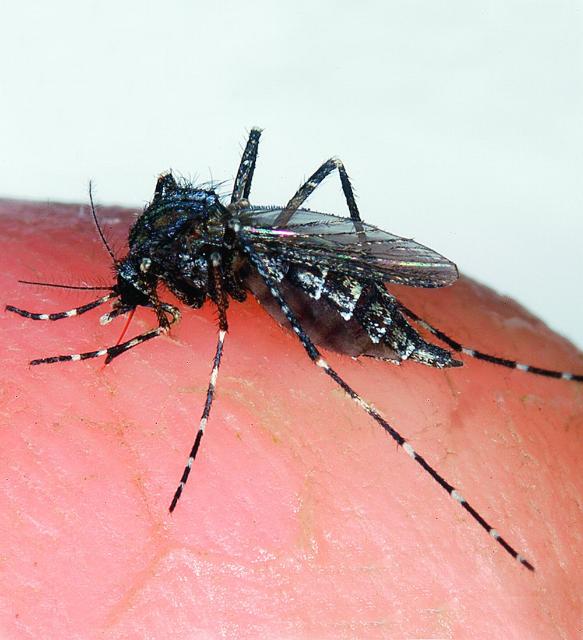
by Les Harrison | Mar 11, 2017
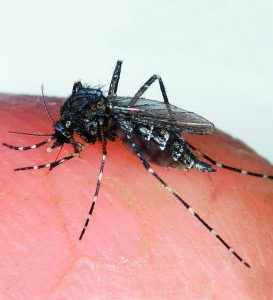 It is an often made wish of summer that the cold weather of winter will kill all the mosquitoes, gnats and no-see-ums. This climactic fete would spare people, pets and livestock the irritation of encountering these low flying pest and their predatory behavior.
It is an often made wish of summer that the cold weather of winter will kill all the mosquitoes, gnats and no-see-ums. This climactic fete would spare people, pets and livestock the irritation of encountering these low flying pest and their predatory behavior.
Unfortunately, the thermometer would have to drop to levels approaching the surface temperature of the planet Neptune to eliminate these winged annoyances.
There are individual steps which will help minimize the potential for exposure to exotic diseases.
Check surroundings for standing water, especially in secluded spots or small quantities. The home landscape and patio garden can produce hundreds, if not thousands, of hungry mosquitos during the summer if standing water is left for long.
Trays and dishes under flower pots commonly collect water which is usually left to evaporate or be absorbed by the plant over time. To mama mosquito this shallow and protected source is an ideal location to deposit eggs for the next generation of voracious airborne insects.
Plants with natural depressions or “cups” can accumulate enough irrigation and rain water to establish an effective mosquito nursery. Even though it may evaporate, these tiny pools will last long enough to hatch many mosquito larvae into potential disease vectors.
Back porch bromeliads can easily deliver this undesirable outcome. So too can mature live oak trees which commonly have hollow spaces between large branches.
Even a wheelbarrow left to the elements can serve as a portable pond to maternity minded mosquitos. Dumping the water on a frequent basis is the easiest method, but there are also larvae-cides which are effective in difficult to dump reservoirs.
Protective clothing when outdoors is useful to reduce exposed skin which mosquitos view as an excellent dining site. Heavier fabrics and loose-fitting designs provide the best protection while maintaining maximum comfort for the wearer.
Minimizing exposure at dusk and dawn, when native mosquitos are most active, will reduce the probability of serving as an unsuspecting blood meal for a swarm or lone hunter. Unfortunately, some of the exotic mosquitos are prowling 24 hours a day and are pleased to attack at any opportunity.
As the weather warms, be ready for mosquito season. This past winter only whetted their appetite.
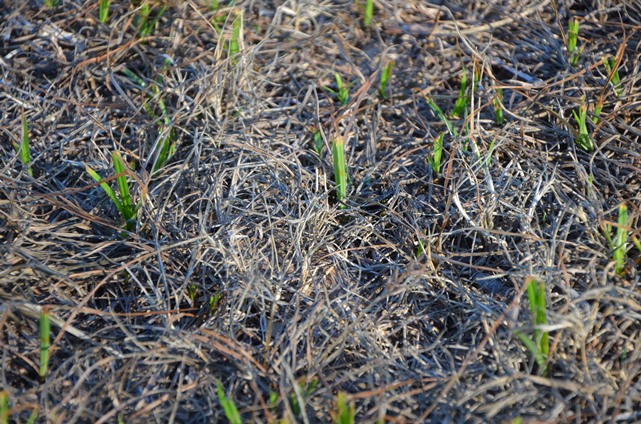
by Les Harrison | Mar 2, 2017
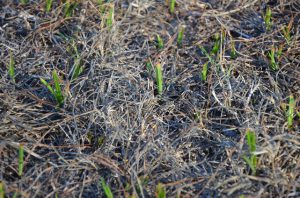
Photo caption: Purple nut sedge is dormant, but quite alive and waiting for warm weather. The best hope for control is to use a pre-emergent herbicide in late February to early March which will prevent this exotic invasive plant from germinating.
Now that March is here the lawn becomes less of an abstraction and more reality.
The lawnmower is no longer silent, meaninglessly taking up space as the grass wakens from its seasonal stupor. Alas, the dormant state has ended as the days are already getting slightly longer.
There is still time to get started with preparations for the ideal spring lawn of 2017. Weather is getting warmer, there is plenty to do.
In addition to doing a soil test, mentioned in previous week’s articles, an accurate weed assessment is also necessary. Though not green and conquering new territory, some of the weeds remain with seed still attached and awaiting distribution.
If the seed are still on the plants, clip the seed pods or remove the plants with the seed intact. Dispose of these properly and do not give them a chance to spread and germinate.
Two notable culprits are nondescript lying dormant waiting for the return of warm, sunny weather. Purple nut sedge and chamberbitter still have countless nutlets and seeds connected to the parent plant.
Purple nut sedge, Cyperus rotundus, grows from every possible sunny location with soil. This non-native plant is a rapidly spreading perennial which will take every opportunity to colonize new locations.
The identifier purple is in its name because there is a purple-tinged section of this sedge where it emerges from the ground. The plant is sometimes referred to as purple nut grass because of its long narrow leaves and its erect growth pattern originating from a nutlike basal bulb.
Chamberbitter, Phyllantus urinaria, is an annual with produces great quantities of seed on the underside of its leaf stems. It will handle full sun or partial shade and quickly form cluster of plants, each contribution seed to the soil.
Areas in the lawn identified as having severe infestations should be marked now for treatment in the near future with a pre-emergent herbicide. This type of herbicide prevents the seed from germinating in the spring.
Purple nut sedge concentrations should be sprayed in late February to early March, and chamberbitter in April since these pest species germinate at different times.
Another winter task is to prepare for seeding bare spots in the lawn. Reading the seed tag attached to the bag should help make the product selection much easier.
Check to confirm the seed has been tested for germination within the year. Also, be sure the grass seed species will grow in Florida.
Sometime generic lawn seed mixes will contain fescue, bluegrass, orchard grass and others turf types which will not grow in north Florida. While they may germinate, their use will only ensure weeds get established for another year.
Lastly, sharpen the lawnmower blade. When the warm weather arrives the mower will be frequently used, but at least the neighbors will be envious of the great green lawn.
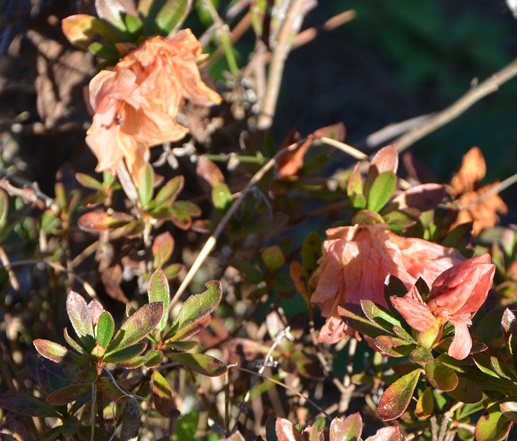
by Les Harrison | Feb 3, 2017
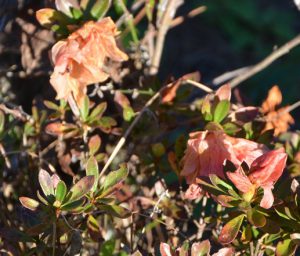
Photo caption: Local azaleas were prematurely blooming
This winter’s exceptional weather has deceived some popular springtime ornamental shrubs and fruit trees into flowering prematurely. Azaleas, for example, began blooming because of winter temperatures mush warmer than average.
There are number of variables which determine when a plant will bloom each year, including the sun, water, and air temperature. To understand why the plants bloom, there should be an understanding of “photoperiodism”, meaning the effects of light and darkness on some plant species.
Certain plants respond to the day length. Some are long day plants which flower in spring and summer, and some are short day plants flowering in fall and winter. Then there are plants which will bloom in any season, identified as day neutral plants.
Long and short day plants will not be directly affected by prevailing weather conditions. For example chrysanthemums, which are short day plant naturally bloom in winter.
These plants can be forced to bloom in summer by keeping them in a dark room for 12 hours a day for several weeks. Many nurseries supplying florist uses this technique and utilize greenhouses with blackout systems. They also use grow lights to produce early season blooms on spring/summer flowers sold for Valentine Day.
For those neutral day plants there is “vernalization”. These plants must be exposed to cold weather to some greater or lesser amount.
Most temperate fruit trees need exposure to cold temperatures. When winters are too mild or contain intermittent warmer periods, dormancy is prematurely terminated and bud break starts.
Most of the exposed buds of these fruit trees can survive freezing temperatures, but many of their flowers will be killed if exposed to a late arriving hard freeze or frost.
After the freeze most of the flowers may appear normal, but the center part of the flower where the reproductive organs reside are killed and result in no fruit formation. Covering plants in-bloom provides some freeze protection.
With a warm early winter, like December 2016, there has been irregular and premature flowering.
Another consideration is fruit trees or shrubs pruned too early winter. Warm weather combined with the pruning stimulates the growth of new shoots.
There is a hormone produced in lateral or terminal shoot buds which travels down the shoots inhibiting their growth. When the terminal shoots are pruned too early the growth inhibiting hormone is removed.
The warm days during winter may cause these newly pruned plants to form new shoots. The new growth is tender and very susceptible to freeze injuries. Pruning in late January or February will likely deliver the best results.
For shrubs like azaleas and gardenias, flower buds are set in summer, long before they can be identified by most people. Losing the buds, no matter the cause, after midsummer drastically decreases the number of flowers the following spring.
To learn more about the spring bloom for 2017, visit the UF/IFAS County Extension website
By: Gohar Umar, FAMU Extension Horticulture Specialist, and Les Harrison, Wakulla County Extension Director
Photo caption: Local azaleas were prematurely blooming
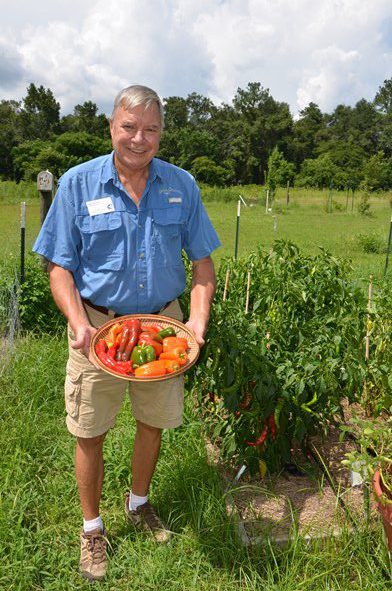
by Les Harrison | Nov 3, 2016
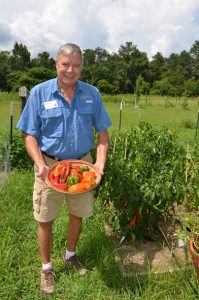
Wakulla Master Gardener Bill Osborne shows off some of the peppers he grew.
Vegetable gardening has many highly desirable benefits. These positive features range from being a good source of exercise, an opportunity to produce fresh produce which may be hard to find in retail establishment, and being able to assure it is produced in a specific way.
In many cases it is difficult, and sometimes tedious, to place an accurate assessment of the economic value on producing vegetables for home consumption. Household budgets in 21st century are problematic enough without literally bean (or some other vegetable) counting to measure profit or loss in the home garden.
As part of an effort involving UF/IFAS Wakulla County Extension Master Gardeners, some popular vegetable categories have had their production assessed. All were grown in the demonstration garden at the UF/IFAS Wakulla County Extension Office on Cedar Avenue in Crawfordville and Master Gardener Bill Osborne coordinated the project.
Several pepper cultivars and an heirloom squash cultivar was chosen to assess. They were selected based on their potential for producing over a long period of time during the summer months.
For the home gardener this means the potential for of eating fresh produce as it matures all season long. It minimized or eliminates the need for preservation expenses, which add to the cost of home production.
Each plant was grown under identical conditions in mushroom compost. The production would qualify as organically produced, but this was not part of the original assessment objective even though it would raise the end value of the useable vegetables.
The cost of the raised growing beds calculated out to approximately $15 per plant, but the expense could be spread over several years. This would reduce the annual expense to about $5.00 per plant for necessary growing inputs to establish the garden.
Values are always a tricky component to establish and necessitate certain assumptions. The prices used in this study were a composite of Big Bend area grocery store and super market prices. Each was rounded to the nearest quarter-dollar to keep calculations simple.
The results are reported on the chart included with this story. The big winner economically was the lemon squash with a retail squash prices averaged $2.25 per pound.
If consumed fresh, each lemon squash plant produced a $65.25 value with $5 of expense. The home gardener netted $60.25 saved in their food budget
Conventionally-grown specialty peppers averaged $4.50 per pound, with organic receiving a much higher price. The big economic winner was the Giant Marconi cultivar producing 10.5 pounds. When expenses were removed, the plant produced $42.25 of retail value.
Close behind was the Mesilla cultivar with 10.12 pounds of production. Its retail production value netted to $40.50 per plant.
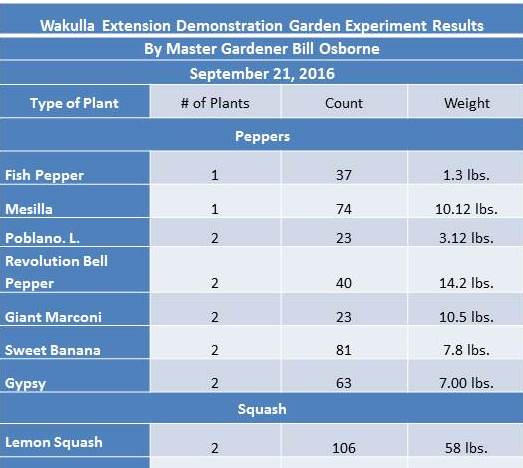
While eating fresh vegetables is a healthy practice, successfully growing them can be a helpful practice for the family budget.
by Les Harrison | Sep 28, 2016
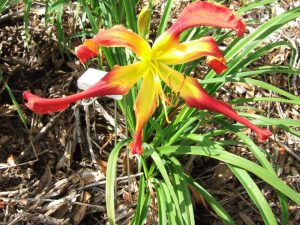
‘Wild Wookie’ Daylily. Photo credit: Sally Menk, Florida Master Gardener.
The daylily is a popular flowering perennial with East Asian origins which has adapted well to Florida landscapes. Plants are available in a wide variety of growth habits, flower shapes and colors, including yellow, orange, red, pink, purple, near-white and shades and combinations of all of these.
Flowering starts in March for early-season bloomers with late-season cultivars starting in mid-May. The typical bloom period is about four to seven weeks, although some varieties bloom even longer.
As their name accurately indicates, daylilies are members of the lily family, in the genus Hemerocallis. “Hemero” is Greek for “day” and “callis” for “beauty,” so the scientific name translates to beauty for a day.
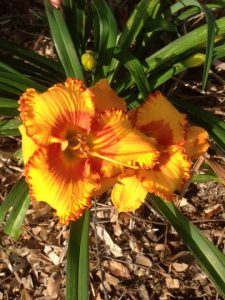
‘Cajun Dreaming’ Daylily. Photo credit: Sally Menk, Florida Master Gardener.
For the adventurous eater, the flower buds and petals of daylilies are edible raw, boiled, stir-fried, steamed, stuffed, or battered and fried. Dried daylily petals, called “golden needles,” are used in numerous Chinese dishes.
Many of the modern varieties of daylilies available today have been developed from native Chinese species. Early settlers from Europe and Asia brought many of the original species with them to America in earlier centuries.
Daylilies grow best in full sun or filtered shade. The darker colored red and purple varieties flourish better in partial shade, while light colored yellows, pinks and pastels varieties need full sun to bring out their best colors. The filtered light level under pine trees is ideal for growing daylilies. Heavy shade should be avoided because it will cause thin, spindly growth and poor flowering.
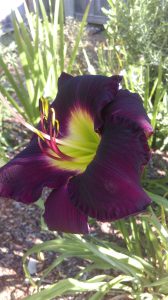
‘Bold Move’ Daylily. Photo credit: Jaci Zwierzchowski, Florida Master Gardener.
The soil of daylily beds should be topped with three to four inches of organic matter, such as peat, compost, or well-rotted manure. The amended soil should be mixed or tilled, leveled and then moistened. The soil pH should be between 6.2 and 6.8, with 6.5 being optimal.
Daylilies survive dry conditions well because of their extensive root systems. However, the number and size of blooms, plant growth, and overall vigor can be adversely affected by prolonged drought.
Daylilies multiply fairly rapidly and plant division is an easy way to propagate them for new locations in the home landscape or to share with friends. Division is best done immediately after the flowering season. Dig the entire clump and shake or wash off the soil without damaging the roots. It is easy to see where the divisions can be made with smaller clumps being easily pulled free to establish a new planting.
The home gardener can expand and share the beauty of these perennials, only spending a little time to accomplish this feat.
To learn more:
Daylilies for Florida

 It is an often made wish of summer that the cold weather of winter will kill all the mosquitoes, gnats and no-see-ums. This climactic fete would spare people, pets and livestock the irritation of encountering these low flying pest and their predatory behavior.
It is an often made wish of summer that the cold weather of winter will kill all the mosquitoes, gnats and no-see-ums. This climactic fete would spare people, pets and livestock the irritation of encountering these low flying pest and their predatory behavior.









